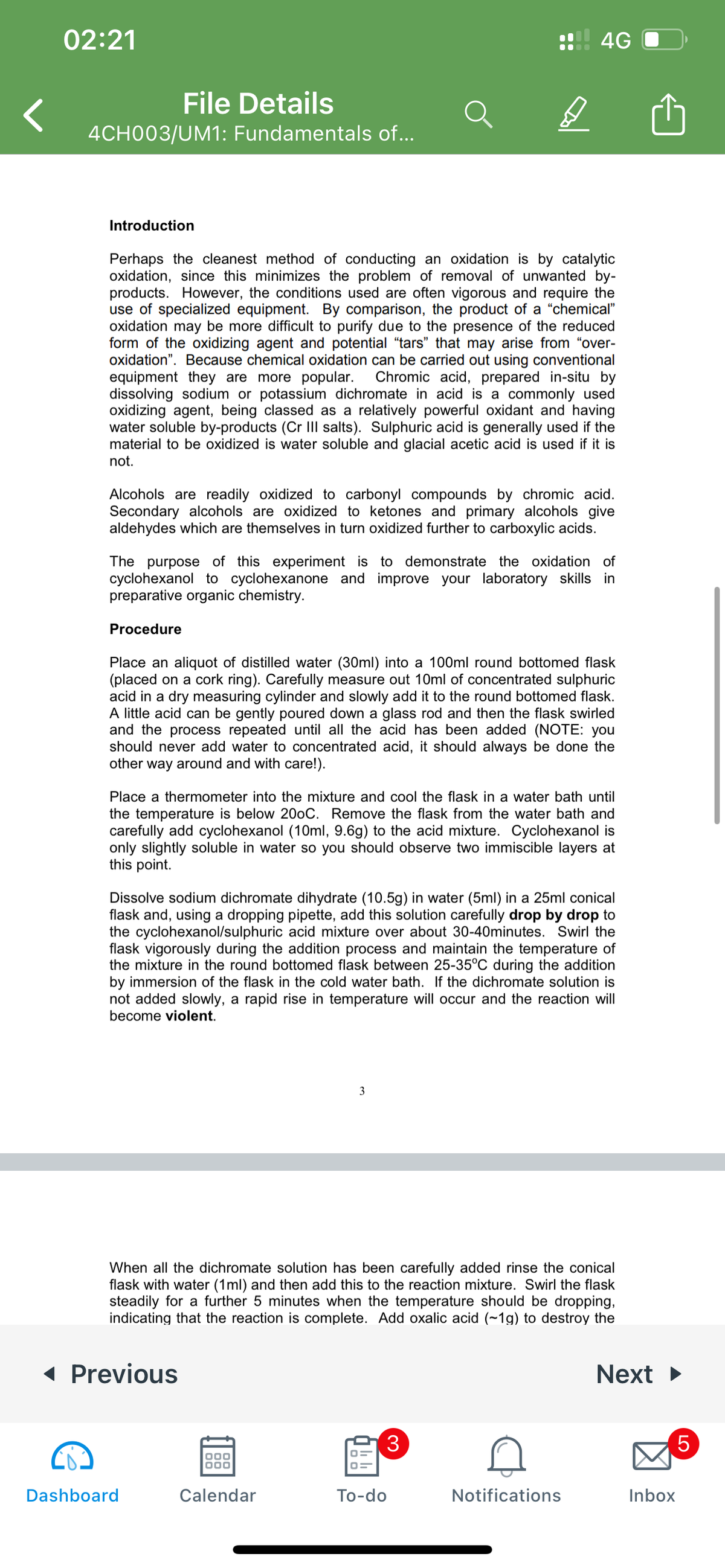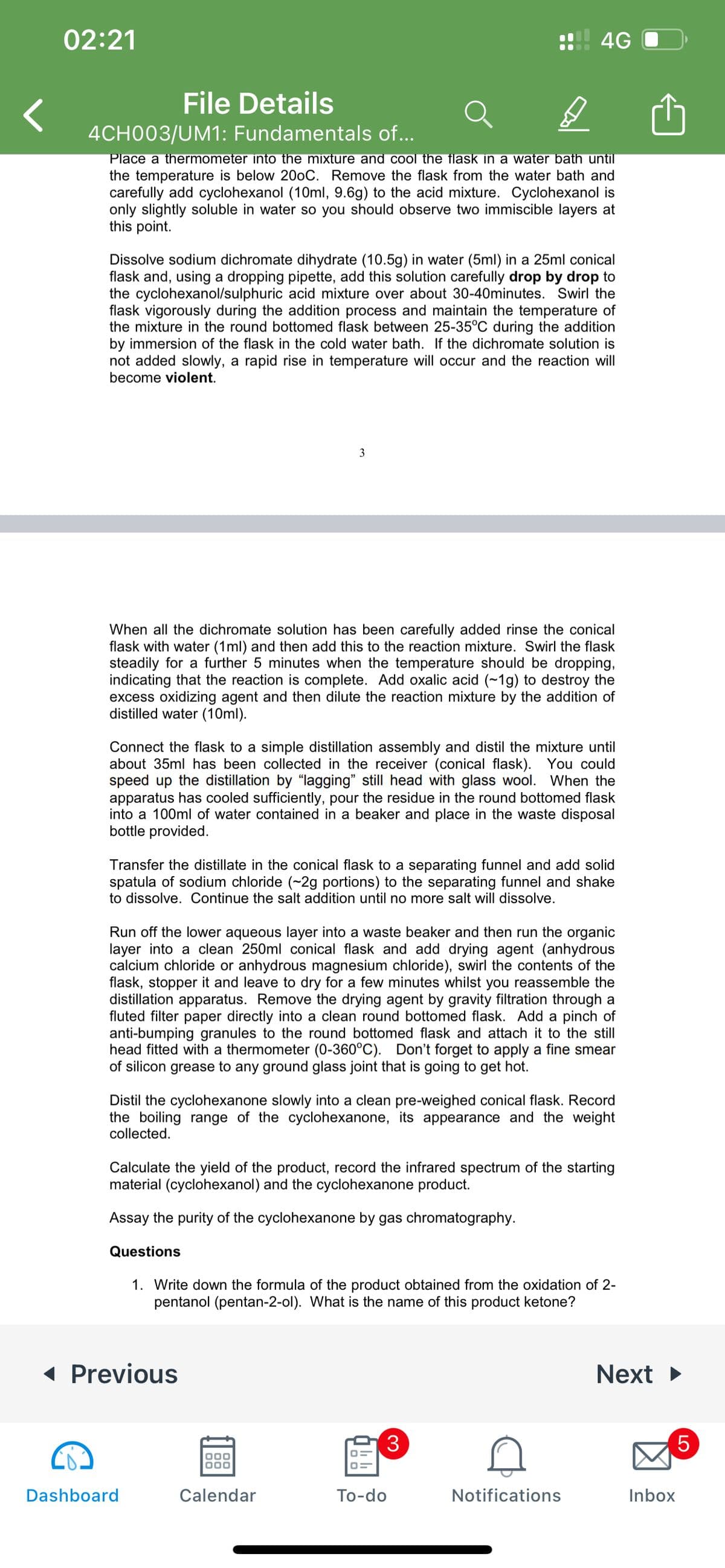Chapter31: Introduction To Analytical Separations
Section: Chapter Questions
Problem 31.19QAP
Related questions
Question

Transcribed Image Text:02:21
4G
File Details
4CH003/UM1: Fundamentals of...
Introduction
Perhaps the cleanest method of conducting an oxidation is by catalytic
oxidation, since this minimizes the problem of removal of unwanted by-
products. However, the conditions used are often vigorous and require the
use of specialized equipment. By comparison, the product of a "chemical"
oxidation may be more difficult to purify due to the presence of the reduced
form of the oxidizing agent and potential "tars" that may arise from "over-
oxidation". Because chemical oxidation can be carried out using conventional
equipment they are more popular.
dissolving sodium or potassium dichromate in acid is a commonly used
oxidizing agent, being classed as a relatively powerful oxidant and having
water soluble by-products (Cr III salts). Sulphuric acid is generally used if the
material to be oxidized is water soluble and glacial acetic acid is used if it is
Chromic acid, prepared in-situ by
not.
Alcohols are readily oxidized to carbonyl compounds by chromic acid.
Secondary alcohols are oxidized to ketones and primary alcohols give
aldehydes which are themselves in turn oxidized further to carboxylic acids.
The purpose of this experiment is to demonstrate the oxidation of
cyclohexanol to cyclohexanone and improve your laboratory skills in
preparative organic chemistry.
Procedure
Place an aliquot of distilled water (30ml) into a 100ml round bottomed flask
(placed on a cork ring). Carefully measure out 10ml of concentrated sulphuric
acid in a dry measuring cylinder and slowly add it to the round bottomed flask.
A little acid can be gently poured down a glass rod and then the flask swirled
and the process repeated until all the acid has been added (NOTE: you
should never add water to concentrated acid, it should always be done the
other way around and with care!).
Place a thermometer into the mixture and cool the flask in a water bath until
the temperature is below 200C. Remove the flask from the water bath and
carefully add cyclohexanol (10ml, 9.6g) to the acid mixture. Cyclohexanol is
only slightly soluble in water so you should observe two immiscible layers at
this point.
Dissolve sodium dichromate dihydrate (10.5g) in water (5ml) in a 25ml conical
flask and, using a dropping pipette, add this solution carefully drop by drop to
the cyclohexanol/sulphuric acid mixture over about 30-40minutes. Swirl the
flask vigorously during the addition process and maintain the temperature of
the mixture in the round bottomed flask between 25-35°C during the addition
by immersion of the flask in the cold water bath. If the dichromate solution is
not added slowly, a rapid rise in temperature will occur and the reaction will
become violent.
3
When all the dichromate solution has been carefully added rinse the conical
flask with water (1ml) and then add this to the reaction mixture. Swirl the flask
steadily for a further 5 minutes when the temperature should be dropping,
indicating that the reaction is complete. Add oxalic acid (~1g) to destroy the
1 Previous
Next
3
000
Dashboard
Calendar
То-do
Notifications
Inbox
LO

Transcribed Image Text:02:21
4G
File Details
4CH003/UM1: Fundamentals of...
Place a thermometer into the mixture and cool the flask in a water bath until
the temperature is below 200C. Remove the flask from the water bath and
carefully add cyclohexanol (10ml, 9.6g) to the acid mixture. Cyclohexanol is
only slightly soluble in water so you should observe two immiscible layers at
this point.
Dissolve sodium dichromate dihydrate (10.5g) in water (5ml) in a 25ml conical
flask and, using a dropping pipette, add this solution carefully drop by drop to
the cyclohexanol/sulphuric acid mixture over about 30-40minutes. Swirl the
flask vigorously during the addition process and maintain the temperature of
the mixture in the round bottomed flask between 25-35°C during the addition
by immersion of the flask in the cold water bath. If the dichromate solution is
not added slowly, a rapid rise in temperature will occur and the reaction will
become violent.
3
When all the dichromate solution has been carefully added rinse the conical
flask with water (1ml) and then add this to the reaction mixture. Swirl the flask
steadily for a further 5 minutes when the temperature should be dropping,
indicating that the reaction is complete. Add oxalic acid (~1g) to destroy the
excess oxidizing agent and then dilute the reaction mixture by the addition of
distilled water (10ml).
Connect the flask to a simple distillation assembly and distil the mixture until
about 35ml has been collected in the receiver (conical flask).
speed up the distillation by "lagging" still head with glass wool. When the
apparatus has cooled sufficiently, pour the residue in the round bottomed flask
into a 100ml of water contained in a beaker and place in the waste disposal
bottle provided.
You could
Transfer the distillate in the conical flask to a separating funnel and add solid
spatula of sodium chloride (~2g portions) to the separating funnel and shake
to dissolve. Continue the salt addition until no more salt will dissolve.
Run off the lower aqueous layer into a waste beaker and then run the organic
layer into a clean 250ml conical flask and add drying agent (anhydrous
calcium chloride or anhydrous magnesium chloride), swirl the contents of the
flask, stopper it and leave to dry for a few minutes whilst you reassemble the
distillation apparatus. Remove the drying agent by gravity filtration through a
fluted filter paper directly into a clean round bottomed flask. Add a pinch of
anti-bumping granules to the round bottomed flask and attach it to the still
head fitted with a thermometer (0-360°C). Don't forget to apply a fine smear
of silicon grease to any ground glass joint that is going to get hot.
Distil the cyclohexanone slowly into a clean pre-weighed conical flask. Record
the boiling range of the cyclohexanone, its appearance and the weight
collected.
Calculate the yield of the product, record the infrared spectrum of the starting
material (cyclohexanol) and the cyclohexanone product.
Assay the purity of the cyclohexanone by gas chromatography.
Questions
1. Write down the formula of the product obtained from the oxidation of 2-
pentanol (pentan-2-ol). What is the name of this product ketone?
( Previous
Next
3
000
Dashboard
Calendar
То-do
Notifications
Inbox
LO
Expert Solution
This question has been solved!
Explore an expertly crafted, step-by-step solution for a thorough understanding of key concepts.
Step by step
Solved in 3 steps with 3 images

Knowledge Booster
Learn more about
Need a deep-dive on the concept behind this application? Look no further. Learn more about this topic, chemistry and related others by exploring similar questions and additional content below.Recommended textbooks for you



Chemistry
Chemistry
ISBN:
9781305957404
Author:
Steven S. Zumdahl, Susan A. Zumdahl, Donald J. DeCoste
Publisher:
Cengage Learning



Chemistry
Chemistry
ISBN:
9781305957404
Author:
Steven S. Zumdahl, Susan A. Zumdahl, Donald J. DeCoste
Publisher:
Cengage Learning

Chemistry: An Atoms First Approach
Chemistry
ISBN:
9781305079243
Author:
Steven S. Zumdahl, Susan A. Zumdahl
Publisher:
Cengage Learning


EBK A SMALL SCALE APPROACH TO ORGANIC L
Chemistry
ISBN:
9781305446021
Author:
Lampman
Publisher:
CENGAGE LEARNING - CONSIGNMENT